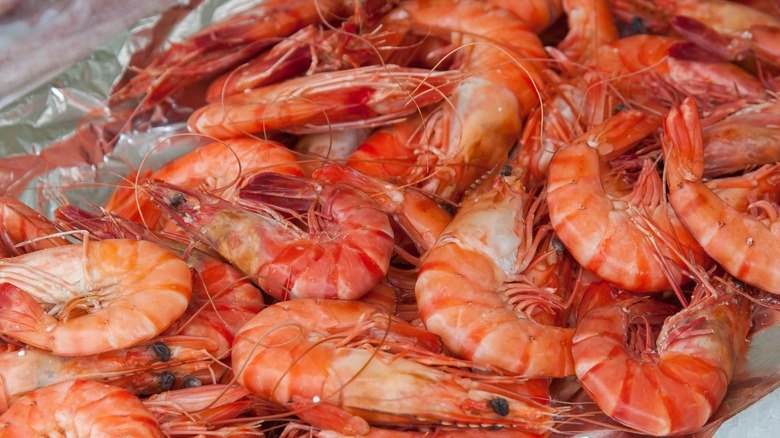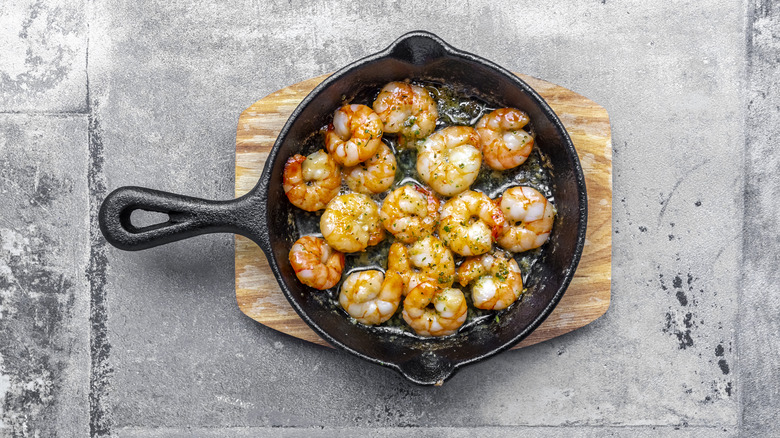Stay Away From Precooked Shrimp Unless You Want To Keep Ruining Your Meals
At first glance, precooked shrimp seems like the ultimate convenience. It's already pink, peeled, and ready to add to any dish you're planning on throwing together. But if you've ever ended up with chewy, flavorless shrimp that barely resembles seafood, you're not alone. The sad truth is that precooked shrimp is almost always a mistake — one that can quietly ruin everything from pasta dishes to fried rice to shrimp tacos.
The problem is baked right into the name: precooked. That shrimp's already been cooked once, which means the second you expose it to heat again (whether in a pan, the oven, or even a warm sauce), you're basically overcooking it. Overcooked shrimp turns rubbery fast, ultimately just sitting in your bowl as a chewy disappointment. Even if you try to keep the reheating gentle, you're still working with a protein that's already been through the wringer. And trust us, it shows.
Why cooking raw shrimp is easier and better than you think
Cooking raw shrimp might sound intimidating if you're not used to working with seafood, but the reality is it's almost laughably easy. Raw shrimp cooks in minutes — literally. Once it turns pink and opaque, it's done. Whether you're boiling, steaming, grilling (make sure it's dry for the juiciest grilled shrimp), or quickly sautéing, it takes less time than cooking pasta or flipping a pancake. No thermometer needed, you can see when it's ready.
Not only is it fast, but cooking raw shrimp also gives you more control over the flavor and texture. You're not stuck trying to bring life back into an ingredient that's already had its best moment. You can season it properly from the start, toss it in a marinade, or cook it with aromatics like garlic, butter, and herbs so the shrimp actually soaks up flavor while it cooks — something precooked shrimp just doesn't do. And if you're making something like shrimp cocktail or a cold pasta salad, it's still better to cook raw shrimp yourself and then chill it. It's fresher, juicier, and has a way cleaner taste.
Frozen raw shrimp is also easy to cook and widely available. It's also more affordable than you might expect. Frozen shrimp often comes deveined and peeled, so you're not dealing with anything messy. Just thaw under cold water for a few minutes and you're ready to go. It's a small extra step that makes a huge difference.
The soggy truth about precooked shrimp
Let's talk about what you're really getting with that bag of precooked shrimp. During industrial processing, shrimp are boiled or steamed, flash-frozen, and packaged. That means, by the time it reaches your skillet, it's already lost some of its flavor and moisture. Add more heat to that and what's left gets tough and stringy with a faintly fishy aftertaste.
And then there's the issue of seasoning — or lack of it. Precooked shrimp doesn't hold flavor well. Toss it in garlic butter or a spicy sauce and you'll still mostly taste nothingness. Because it's already cooked, the shrimp doesn't absorb seasonings well. You might end up dumping more salt or sauce than you'd normally use just to make it palatable; and even then, it's a struggle.
Worst of all? It often looks deceptively good. That plump pink color tricks people into thinking it's ready to go, but don't let appearances fool you. It might save you five minutes now, but you'll pay for it in texture and taste.
So, if you're tired of rubbery shrimp hijacking your meals, do yourself a favor and skip the precooked stuff and grab raw shrimp instead. Your quick and easy stir-fries will be more flavorful, your tacos more satisfying, and your shrimp cocktail will finally taste like it came from a real kitchen — not a processing plant.


